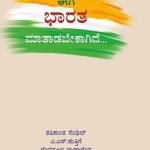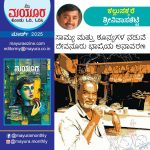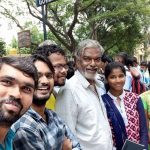Reconciling Gandhi with Ambedkar-A DISCUSSION By H.S.Komalesha
[In the August 22, 2015 issue of Economic & Political Weekly, H.S. Komalesha discussed using Devanur Mahadeva’s thoughts in response to the controversy created by Arundhati Roy and Raj Mohan Gandhi’s writing on Gandhi/Ambedkar. Economic & Political Weekly august 22, 2015 ರ ಸಂಚಿಕೆಯಲ್ಲಿ ಗಾಂಧಿ/ ಅಂಬೇಡ್ಕರ್ ಕುರಿತ ಅರುಂಧತಿ ರಾಯ್ ಮತ್ತು ರಾಜ್ ಮೋಹನ್ ಗಾಂಧಿ ಅವರ ಬರಹ ಸೃಷ್ಟಿಸಿರುವ ವಿವಾದಕ್ಕೆ ಉತ್ತರವಾಗಿ ದೇವನೂರ ಮಹಾದೇವ ಅವರ ಚಿಂತನೆಗಳನ್ನು ಬಳಸಿಕೊಂಡು ಹೆಚ್. ಎಸ್ . ಕೋಮಲೇಶ ಅವರು ಮಾಡಿರುವ ಚರ್ಚೆ.]

{H S Komalesha (hskomalesha@gmail.com) is at the Department of Humanities and Social Sciences, Indian Institute of Technology, Kharagpur.}
{This article carries forward the discussion on the controversy between M K Gandhi and B R Ambedkar occasioned by Arundhati Roy’s essay, “The Doctor and the Saint.” It takes note of Rajmohan Gandhi’s criticisms of Roy in “Independence and Social Justice: The Ambedkar–Gandhi Debate” (EPW, 11 April 2015) and Roy’s response, “All the World’s aHalf-Built Dam” (EPW, 20 June 2015) to stress that the views of Gandhi and Ambedkar are not as conflicting as they are made out to be.}
The noted writer and activist, Arundhati Roy’s essay, “The Doc- tor and the Saint” (2014) has led to scholars revisiting the sites of spars between M K Gandhi and B R Ambedkar. The essay attracted the ire of both Gandhians and Ambedkarites—and those with deep entrenched positions in the Gandhi–Ambedkar debate. It raked up—for all the right and wrong reasons an old controversy that had been dormant for many decades, finding occasional expression in the writings of Dalit thinkers and followers of Ambedkar.
Without concealing her strong admiration for Ambedkar (the “doctor” in the title of her essay) and his ideologies, Roy repudiates Gandhi and his methods in matters related to caste. She rips apart the aura surrounding the man, referred to as the “saint” in the title of her essay with a slant on the term. The now infamous Poona Pact of 24 September 1932 forms the backdrop of Roy’s essay and her purpose seems to expose the “unholy” role Gandhi played in silencing Ambedkar and thereby weakening the empowerment of oppressed sections strangely a common cause for both Ambedkar and Gandhi throughout their lives, albeit from different directions. Apart from kicking up much dust around Gandhi, Roy opened up the floodgates of fury that had been seething in Ambed- kar followers. The fury erupted as if it was waiting for a nudge from a contemporary thinker.
This discussion piece takes off from the recent article by Rajmohan Gandhi in the EPW, “Independence and Social Justice: The Ambedkar–Gandhi Debate” (2015) and Roy’s vigorous response to it (2015). It presses upon the political need to locate the original debate between Gandhi and Ambedkar in the realm of reconciliation, and not resentment.
Two Insights
Is there a way to come to peaceful terms with the fierce ideological fights between Gandhi and Ambedkar? Devanoora Mahadeva (2013), a gifted writer and Dalit activist of the Kannada world and Siddalingaiah, a major Kannada Dalit poet offer interesting insights into understanding the differences between the two great personalities. Sidda- lingaiah uses an interesting metaphor to speak of the differences between Gandhi and Ambedkar: a conversation between a grandfather and grandson. Speaking of Gandhi, the grandfather tells his grandson:
‘During our times, we had a person called Gandhi who chased the British out of India and won freedom for us. He is the man be- hind the way we are now.’
The grandson refers to Ambedkar and says:
‘Grandpa, when you were young, there was a person from our community called Ambedkar. Thanks to his sustained struggles, we have been able to live the way we are now.’
Acknowledging the significance of this insight, Mahadeva writes in his Kannada article, “Gandhi and Ambedkar—A Few Words”:
If the ripened fruit speaks of Gandhi to the bud, it is the bud that speaks of Ambedkar to the fruit! If the first has slow pace, the sec- ond has speed. Because of this difference in movement, the objective that both Gandhi and Ambedkar shared though is identical, looks different and contradictory.
The difference in the pace and direction of the efforts of Gandhi and Ambedkar could have led the later generations to see the two as poles apart or as two political opponents who never met eye to eye. Probably, the first generation of the educated Dalits, who had felt the live presence of Gandhi and Ambedkar in their lives and were the direct beneficiaries of the struggles of these leaders against the caste system could not even think of separating the common legacies of Gandhi and Ambedkar. Though they had witnessed public debates between Gandhi and Ambedkar over problems and solutions related to caste system, they never faced the crisis of choosing between the two. That is because they would have caught the pulse of both the thinkers. Unfortunately, the wisdom of this generation could not prevail upon Dalits and Dalit thinkers of later and younger generations. They began venerating Ambedkar as their sole saviour to such an extent that even taking out the name of Gandhi along with Ambedkar became an anathema to them. The drift between contemporary Dalit thinkers and Gandhi became so serious and virulent that some of the Dalit organisations boycotted the epic biopic on Gandhi by Richard Attenborough. The Dalit Sangharsha Samiti in Karnataka was amongst the organisations that boycotted the film.
The Older Generation
How did then the older generations of Dalits construe the quarrels between Gandhi and Ambedkar? Were they indifferent to these quarrels? As Mahadeva writes:
‘The older generations considered these fights as quarrel between parents over the best interests of their children; for instance, if the father argues for enrolling the child to a Kannada Medium school, the mother might insist on an English medium school. Obviously, a fight ensues. Except the interest of the child, what else is there in the fight? Why was there a fierce fight over the Poona Pact? Isn’t it like saying, ‘it’s true, I may have some major shortcomings; but don’t desert me for that?’
We tend to pitch Gandhi against Ambedkar even when referring to their opinion on Hinduism. It is almost akin to a boxing fight. We quote from each other’s books, letters and speeches and derive pleasure from who scored over whom and with how many points. This is more or less what Roy does in her essay. Such decontextualising of differences between Ambedkar and Gandhi is insensitive because it does disservice to their common objective.
We need to understand the fundamental difference between both the thinkers in terms of their ideological temperaments. If Ambedkar’s perspectives are marked by sharp reasoning and logic, Gandhi’s views are shaped by forces beyond logical reasoning. Such difference between contemporaries could well have lead to quarrels. We must learn to look at these fights in terms of the benefits they have had on society. Mahadeva employs a brilliant metaphor of two persons with equal stakes in a house to describe the spar between the two thinkers. He writes:
Gandhi appears to be like a person standing within the dilapidated house of Hinduism to cut the moth-eaten pillars of inequality, caste and hierarchy; whereas, Ambedkar looks like an angry youngster, a rebel throwing stones at the bedraggled mansion breed- ing inequality. Because of this, some stones Ambedkar threw might have hit Gandhi and spilled his blood. And, the world watching the episode from outside can relay the event as a bitter and gory fight between Gandhi and Ambedkar. In reality, weren’t they both engaged at the same task?
By keeping Gandhi away from Ambedkar, the oppressed sections may not be gaining much. Turning away from Gandhi would be like doing disservice to Ambedkar as well. Our times stand testimony to the salience of Gandhi’s methods for a democratic society’s collective fight against neocolonial market forces. Our times also demand synergising all sources of strength in the collective struggle against communal forces. Only then can we add true meaning to the memory of Ambedkar and Gandhi.
References
Gandhi, Rajmohan (2015): “Independence and Social Justice: The Ambedkar–Gandhi Debate,”
Economic & Political Weekly, 11 April, Vol 50, No 15.
Mahadeva, Devanoora (2013): Edege Bidda Akshara,
Bengaluru: Abhinava.
Roy, Arundhati (2014): “The Doctor and the Saint” (Introduction), Annihilation of Caste, by
B R Ambedkar, New Delhi: Navayana.
—(2015): “All the World’s a Half-Built Dam,”
Economic & Political Weekly, 20 June, Vol 50, No 25.







